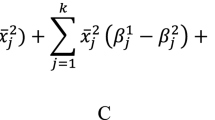Abstract
The data available for estimating welfare indicators are often inconveniently incomplete data: they may be censored or truncated. Furthermore, for robustness reasons, researchers sometimes use trimmed samples. By using the statistical tool known as the Influence Function we derive distribution-free asymptotic variances for wide classes of welfare indicators not only in the complete data case, but also in the important cases where the data have been trimmed, censored or truncated.
Similar content being viewed by others
References
Angrist, J. D. and Krueger, A. B.: Empirical strategies in labor economics, In: O. Ashenfelter and D. Card (eds.), Handbook of Labor Economics, Vol. 3A, North-Holland, Amsterdam, 1999, Chapter 23, p. 1347.
Beach, C. M. and Davidson, R.: Distribution-free statistical inference with Lorenz curves and income shares, Review of Economic Studies 50 (1983), 723–735.
Boos, D. D. and Serfling, R. J.: A note on differential and the CLT and LIL for statistical functions, with application to M-estimates, Ann. Statist. 8 (1980), 618–624.
Cowell, F. A.: Sampling variance and decomposable inequality measures, J. Econometrics 42 (1989), 27–41.
Cowell, F. A.: Estimation of inequality indices, In: J. Silber (ed.), Handbook on Income Inequality Measurement, Kluwer Academic Publishers, Dordrecht, 1999.
Cowell, F. A.: Measurement of inequality, In: A. B. Atkinson and F. Bourguignon (eds.), Handbook of Income Distribution, North-Holland, Amsterdam, 2000, Chapter 2.
Cowell, F. A. and Victoria-Feser, M.-P.: Poverty measurement with contaminated data: A robust approach, European Economic Review 40 (1996), 1761–1771.
Cowell, F. A. and Victoria-Feser, M.-P.: Robustness properties of inequality measures, Econometrica 64 (1996), 77–101.
Cowell, F. A. and Victoria-Feser, M.-P.: Statistical inference for Lorenz curves with censored data, Distributional Analysis Discussion Paper 35, STICERD, London School of Economics, London WC2A 2AE, 1998.
Cowell, F. A. and Victoria-Feser, M.-P.: Distributional dominance with dirty data, Distributional Analysis Discussion Paper 51, STICERD, London School of Economics, LondonWC2A 2AE, 2001.
Cowell, F. A. and Victoria-Feser, M.-P.: Robust Lorenz curves: A semi-parametric approach, Distributional Analysis Discussion Paper 50, STICERD, London School of Economics, London WC2A 2AE, 2001.
Cowell, F. A. and Victoria-Feser, M.-P.:Welfare rankings in the presence of contaminated data, Econometrica 70 (2002), 1221–1233.
Dardanoni, V. and Forcina, A.: Inference for Lorenz curve orderings, The Econometrics J. 2 (1999), 49–75.
Deville, J.-C.: Variance estimation for complex statistics and estimators: Linearization and residual techniques, Statistics Canada: Survey Methodology 25 (1999), 193–203.
Efron, B.: The Jackknife, the Bootstrap and Other Resampling Plans, Vol. 38, Society for Industrial and Applied Mathematics, Philadelphia, 1982.
Fernholz, L. T.: Von Mises Calculus for Statistical Functionals, Lecture Notes in Statistics 19, Springer, New York, 1983.
Gastwirth, J. L.: A general definition of the Lorenz curve, Econometrica 39 (1971), 1037–1039.
Gastwirth, J. L.: Large-sample theory of some measures of inequality, Econometrica 42 (1974), 191–196.
Gastwirth, J. L., Nayak, T. K. and Krieger, A. N.: Large sample theory for the bounds on the Gini and related indices from grouped data, J. Business and Economic Statistics 4 (1986), 269–273.
Goldie, C.M.: Convergence theorems for empirical Lorenz curves and their inverses, Adv. Appl. Probab. 9 (1977), 765–791.
Gottschalk, P. and Moffitt, R. A.: Trends in the covariance structure of earnings in the US: 1969- 1987, Mimeo, Brown University, 1995.
Hampel, F. R.: A general qualitative definition of robustness, Ann. Math. Statist. 42 (1971), 1887–1896.
Hampel, F. R.: The influence curve and its role in robust estimation, J. Amer. Statist. Assoc. 69 (1974), 383–393.
Hampel, F. R., Ronchetti, E. M., Rousseeuw, P. J. and Stahel, W. A.: Robust Statistics: The Approach Based on Influence Functions, Wiley, New York, 1986.
Hoeffding, W.: A class of statistics with asymptotically normal distribution, Ann. Math. Statist. 19 (1948), 293–325.
Huber, P. J.: Robust Statistics, Wiley, New York, 1981.
Instituto Nacional de Estadistica: Encuesta de presupuestos familiares 1990- 1991, Metodologia, Madrid, 1992.
Koenker, R. and Basset, G.: Regression quantiles, Econometrica 46 (1978), 107–112.
Monti, A. C.: The study of the Gini concentration ratio by means of the influence function, Statistica 51 (1991), 561–577.
Moore, D. S.: An elementary proof of asymptotic normality of linear functions of order statistics, Ann. Math. Statist. 39 (1968), 263–265.
Mosteller, F.: On some useful “inefficient” statistics, Ann. Math. Statist. 17 (1946), 377–408.
Rao, C. R.: Linear Statistical Inference and Its Applications, Wiley, New York, 1973.
Reeds, J. A.: On the definition of von Mises functionals, Research Report S 44, Department of Statistics, Harvard University, Cambridge, MA, 1976.
Schechtman, A.: On estimating the asymptotic variance of a function of U statistics, The American Statistician 45 (1991), 103–106.
Sen, A. K.: Poverty: An ordinal approach to measurement, Econometrica 44 (1976), 219–231.
Serfling, W.: Approximation Theorems in Mathematical Statistics, Wiley, New York, 1980.
Shorack, G. R.: Functions of order statistics, Ann. Math. Statist. 43 (1972), 412–427.
Shorrocks, A. F.: Ranking income distributions, Economica 50 (1983), 3–17.
Stigler, S. M.: Linear functions of order statistics with smooth weight functions, Ann. Statist. 2 (1974), 676–693.
Author information
Authors and Affiliations
Rights and permissions
About this article
Cite this article
Cowell, F.A., Victoria-Feser, MP. Distribution-Free Inference for Welfare Indices under Complete and Incomplete Information. The Journal of Economic Inequality 1, 191–219 (2003). https://doi.org/10.1023/B:JOEI.0000004637.12354.c7
Issue Date:
DOI: https://doi.org/10.1023/B:JOEI.0000004637.12354.c7




